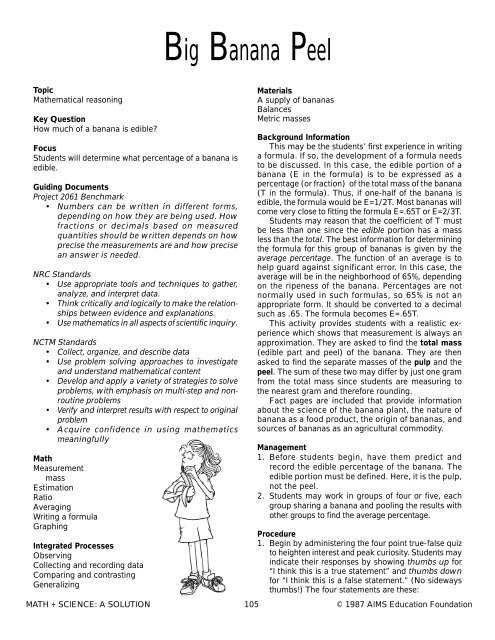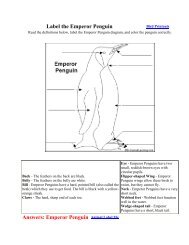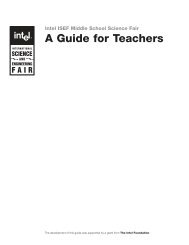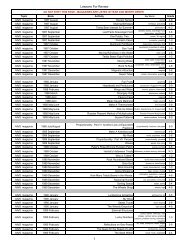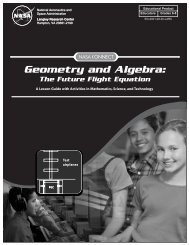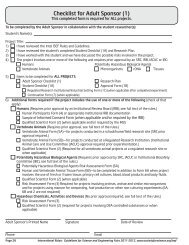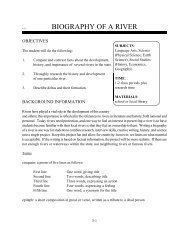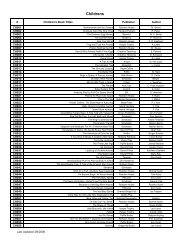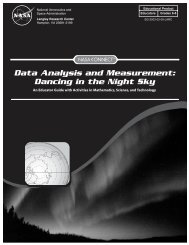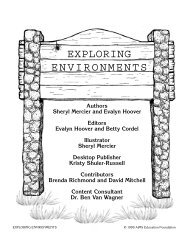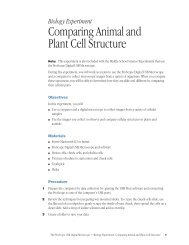Big Banana Peel - Center for Math and Science Education
Big Banana Peel - Center for Math and Science Education
Big Banana Peel - Center for Math and Science Education
Create successful ePaper yourself
Turn your PDF publications into a flip-book with our unique Google optimized e-Paper software.
<strong>Big</strong> <strong>Banana</strong> <strong>Peel</strong>Topic<strong>Math</strong>ematical reasoningKey QuestionHow much of a banana is edible?FocusStudents will determine what percentage of a banana isedible.Guiding DocumentsProject 2061 Benchmark• Numbers can be written in different <strong>for</strong>ms,depending on how they are being used. Howfractions or decimals based on measuredquantities should be written depends on howprecise the measurements are <strong>and</strong> how precisean answer is needed.NRC St<strong>and</strong>ards• Use appropriate tools <strong>and</strong> techniques to gather,analyze, <strong>and</strong> interpret data.• Think critically <strong>and</strong> logically to make the relationshipsbetween evidence <strong>and</strong> explanations.• Use mathematics in all aspects of scientific inquiry.NCTM St<strong>and</strong>ards• Collect, organize, <strong>and</strong> describe data• Use problem solving approaches to investigate<strong>and</strong> underst<strong>and</strong> mathematical content• Develop <strong>and</strong> apply a variety of strategies to solveproblems, with emphasis on multi-step <strong>and</strong> nonroutineproblems• Verify <strong>and</strong> interpret results with respect to originalproblem• Acquire confidence in using mathematicsmeaningfully<strong>Math</strong>MeasurementmassEstimationRatioAveragingWriting a <strong>for</strong>mulaGraphingIntegrated ProcessesObservingCollecting <strong>and</strong> recording dataComparing <strong>and</strong> contrastingGeneralizingMaterialsA supply of bananasBalancesMetric massesBackground In<strong>for</strong>mationThis may be the students’ first experience in writinga <strong>for</strong>mula. If so, the development of a <strong>for</strong>mula needsto be discussed. In this case, the edible portion of abanana (E in the <strong>for</strong>mula) is to be expressed as apercentage (or fraction) of the total mass of the banana(T in the <strong>for</strong>mula). Thus, if one-half of the banana isedible, the <strong>for</strong>mula would be E=1/2T. Most bananas willcome very close to fitting the <strong>for</strong>mula E=.65T or E=2/3T.Students may reason that the coefficient of T mustbe less than one since the edible portion has a massless than the total. The best in<strong>for</strong>mation <strong>for</strong> determiningthe <strong>for</strong>mula <strong>for</strong> this group of bananas is given by theaverage percentage. The function of an average is tohelp guard against significant error. In this case, theaverage will be in the neighborhood of 65%, dependingon the ripeness of the banana. Percentages are notnormally used in such <strong>for</strong>mulas, so 65% is not anappropriate <strong>for</strong>m. It should be converted to a decimalsuch as .65. The <strong>for</strong>mula becomes E=.65T.This activity provides students with a realistic experiencewhich shows that measurement is always anapproximation. They are asked to find the total mass(edible part <strong>and</strong> peel) of the banana. They are thenasked to find the separate masses of the pulp <strong>and</strong> thepeel. The sum of these two may differ by just one gramfrom the total mass since students are measuring tothe nearest gram <strong>and</strong> there<strong>for</strong>e rounding.Fact pages are included that provide in<strong>for</strong>mationabout the science of the banana plant, the nature ofbanana as a food product, the origin of bananas, <strong>and</strong>sources of bananas as an agricultural commodity.Management1. Be<strong>for</strong>e students begin, have them predict <strong>and</strong>record the edible percentage of the banana. Theedible portion must be defined. Here, it is the pulp,not the peel.2. Students may work in groups of four or five, eachgroup sharing a banana <strong>and</strong> pooling the results withother groups to find the average percentage.Procedure1. Begin by administering the four point true-false quizto heighten interest <strong>and</strong> peak curiosity. Students mayindicate their responses by showing thumbs up <strong>for</strong>“I think this is a true statement” <strong>and</strong> thumbs down<strong>for</strong> “I think this is a false statement.” (No sidewaysthumbs!) The four statements are these:MATH + SCIENCE: A SOLUTION 105 © 1987 AIMS <strong>Education</strong> Foundation
TheTruth About <strong>Banana</strong>sScientific NameFamily: MusaceaeGenus: MusaSpecies: Musa acuminata (common banana)Musa paradisica (plantain banana)Food ValueWater: 75.7%Protein: 1.1 gFat: 0.2 gCarbohydrates: 22.2 gWhich of these statements are true?a. The banana is a berry.b. <strong>Banana</strong>s grow on trees.Food Energy:Approximately 1 calorie per gramVitamin A: 190 IUThiamine (B 1): 0.05 mgRiboflavin (B 2): 0.06 mgPhosphorous: 26 mgPotassium: 370 mgVitamin C: 10 mgNiacin: .7 mgCalcium: 8 mgIron: .7 mgSodium: 1 mgc. Pound <strong>for</strong> pound, bananas are the most widely sold fruit in the United States.d. <strong>Banana</strong>s are highly nutritious <strong>and</strong> easily digestible.There are over100 varieties ofbananas!The <strong>Banana</strong> PlantYou may be surprised to learn that bananas are berries! Aberry is a simple fruit having a skin surrounding one ormore seeds in a fleshy pulp. Botanists classifygrapes, tomatoes, currants, <strong>and</strong> bananas as berries.<strong>Banana</strong>s grow on a tropical plant that is not atree—it has no trunk. <strong>Banana</strong>s are gigantic herbsthat spring from underground stems. What appears to be the trunk is a false stem <strong>for</strong>medby tightly wrapped leaf sheaths that grows to a height of three or more meters. From thetop, 10-20 large oblong to elliptical-shaped leaves fan out. It takes 5-18 months to growthe one stalk of bananas it bears. <strong>Banana</strong>s on the stalk point upward. After harvesting,the plant is cut down <strong>and</strong> the underground rootstock produces new shoots <strong>for</strong> the next plant.MATH + SCIENCE: A SOLUTION 107 © 1987 AIMS <strong>Education</strong> Foundation
Theof <strong>Banana</strong>sIt is generally agreed that the banana originated in Malaysia<strong>and</strong> the East Indies. It is frequently referred to in ancient Hindu,Chinese, Greek, <strong>and</strong> Roman literature<strong>and</strong> in sacred texts of Orientalcultures. It is said that the armiesof Alex<strong>and</strong>er the Great fighting in Indiawere the first Europeans to learn about bananas.Theophratus, in a book written in the 4th century B.C. <strong>and</strong>considered to be the first scientific botanical work known,described the banana. The Arabs introduced bananas to theNear East <strong>and</strong> Mediterranean. They came to the CaribbeanIsl<strong>and</strong>s <strong>and</strong> Mexico shortly after Columbus’ voyages. It isinteresting to note that the Polynesiansintroduced bananas throughout the Pacificregion during their migration.The name of one species, Musasapientum, means “fruit of the wise men.”This name derives from the legend thatsages in India sat under banana plantsduring times of meditation. Today wise men, women,boys <strong>and</strong> girls eat bananas because they are such anexcellent <strong>and</strong> nutritious food.Sources of SupplyIn the Western Hemisphere:Ecuador (largest exporter) MexicoHonduras (chief export) Dominican RepublicPanama (chief export) BrazilCosta RicaColumbiaGuatemalaIn Asia:TaiwanIn Africa:Canary Isl<strong>and</strong>sEthiopiaCameroonGuineaNigeriaNext time you are in a store, carefully examine the label on a bunch of bananas.Generally, the source country is named on it in small type. See how many differentsource countries you can find on banana labels!!MATH + SCIENCE: A SOLUTION 108 © 1987 AIMS <strong>Education</strong> Foundation
The <strong>Banana</strong> as FoodPound <strong>for</strong> pound, bananas are the most widely soldfruit in the United States. They are the most importantof all commercial fruits, close to the combined productionof all citrus fruits.<strong>Banana</strong>s are an excellent food source of potassium, vitamins A & C, <strong>and</strong> quickenergy. They are low in protein <strong>and</strong> fat. They are an excellent between-meal snack<strong>and</strong> one of the most easily digested <strong>and</strong> nutritious natural foods. A medium-sizebanana has about 125-130 calories, or about one calorie per gram. <strong>Banana</strong>s arerecommended <strong>for</strong> low-fat, low-sodium diets.<strong>Banana</strong>s come with their own wrapping, ready to go into lunch boxes. They aretasty sliced on breakfast cereals, in fruit salads, <strong>and</strong> gelatin desserts. <strong>Banana</strong>s areused in the preparation of flavoring. Vacuum dehydration yields banana crystals, alight-brown powder used in ice cream, bakery products <strong>and</strong> milk-based beverages.“Tree-ripened” would not make good advertising <strong>for</strong> bananas. If allowed to ripen onthe plant they are starchy, mealy, or rotten <strong>and</strong> there<strong>for</strong>e inedible. They are sent tomarket green <strong>and</strong> are ripened in air-tight rooms with controlled humidity <strong>and</strong>temperature. These conditions permit nearly all of the starch to be converted intosugar <strong>for</strong> good taste. The banana is at its best eating condition when the brightyellow peeling is flecked with brown specks, known as “sugar specks.” Look <strong>for</strong>plump, well-filled fruit.A plantain is a cooking variety of banana that islarger than our common banana. It is a staplefood in the tropics. Plantains are starchy whengreen <strong>and</strong> take the place of potatoes. Plantain chipsare the Latin-American equivalent of our potato chips!MATH + SCIENCE: A SOLUTION 109 © 1987 AIMS <strong>Education</strong> Foundation
MATH + SCIENCE: A SOLUTION 110 © 1987 AIMS <strong>Education</strong> Foundation<strong>Banana</strong> A<strong>Banana</strong> B<strong>Banana</strong> C<strong>Banana</strong> D<strong>Banana</strong> E<strong>Banana</strong> F<strong>Banana</strong> G<strong>Banana</strong> HSumAverageThe <strong>Big</strong> <strong>Banana</strong> <strong>Peel</strong>!Prediction: What part of a banana is edible?%Complete the table.Total Mass (g)Mass of<strong>Peel</strong>ing (g)Mass of EdiblePart (g)Ratio of Edible (g)Total Mass (g)Percent of <strong>Banana</strong>that is EdibleFrom this data, write three things you now know about these bananas.
MATH + SCIENCE: A SOLUTION 111 © 1987 AIMS <strong>Education</strong> FoundationLet E st<strong>and</strong> <strong>for</strong> Edible <strong>and</strong> T <strong>for</strong> the total. E= ___ TWrite a <strong>for</strong>mula to show the amount of the edible portion.AverageHGF<strong>Banana</strong>EDCBA0% 10% 20% 30% 40% 50% 60% 70% 80% 90% 100%Construct a bar graph showing the percent of each banana that is edible.The <strong>Big</strong> <strong>Banana</strong> <strong>Peel</strong>!


